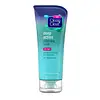What's inside
What's inside
 Key Ingredients
Key Ingredients

 Benefits
Benefits

 Concerns
Concerns

 Ingredients Side-by-side
Ingredients Side-by-side

Water
Skin ConditioningSodium Laureth Sulfate
CleansingGlycerin
HumectantCocamidopropyl Betaine
CleansingCoco-Betaine
CleansingDecyl Glucoside
CleansingPEG-40 Hydrogenated Castor Oil
EmulsifyingPEG-7 Glyceryl Cocoate
EmulsifyingCitric Acid
BufferingSodium Chloride
MaskingSodium Benzoate
MaskingMelaleuca Alternifolia Leaf Oil
AntioxidantCoco-Glucoside
CleansingGlyceryl Oleate
EmollientPEG-120 Methyl Glucose Dioleate
EmulsifyingSodium Gluconate
Skin ConditioningCalophyllum Inophyllum Seed Oil
AntimicrobialAllantoin
Skin ConditioningMenthol
MaskingPanthenol
Skin ConditioningSalicylic Acid
MaskingSodium Hydroxide
BufferingLimonene
PerfumingLeptospermum Petersonii Oil
MaskingTocopherol
AntioxidantHydrogenated Palm Glycerides Citrate
EmollientCI 19140
Cosmetic ColorantCI 42090
Cosmetic ColorantWater, Sodium Laureth Sulfate, Glycerin, Cocamidopropyl Betaine, Coco-Betaine, Decyl Glucoside, PEG-40 Hydrogenated Castor Oil, PEG-7 Glyceryl Cocoate, Citric Acid, Sodium Chloride, Sodium Benzoate, Melaleuca Alternifolia Leaf Oil, Coco-Glucoside, Glyceryl Oleate, PEG-120 Methyl Glucose Dioleate, Sodium Gluconate, Calophyllum Inophyllum Seed Oil, Allantoin, Menthol, Panthenol, Salicylic Acid, Sodium Hydroxide, Limonene, Leptospermum Petersonii Oil, Tocopherol, Hydrogenated Palm Glycerides Citrate, CI 19140, CI 42090
Water
Skin ConditioningGlycerin
HumectantSodium Laureth Sulfate
CleansingMicrocrystalline Cellulose
AbsorbentCellulose
AbsorbentLauryl Glucoside
CleansingAcrylates/C10-30 Alkyl Acrylate Crosspolymer
Emulsion StabilisingPhenoxyethanol
PreservativeParfum
MaskingMethylparaben
PreservativeMicrocrystalline Wax
Emulsion StabilisingSodium Hydroxide
BufferingMenthol
MaskingDisodium EDTA
Sodium Benzotriazolyl Butylphenol Sulfonate
UV AbsorberUltramarines
CI 73360
Cosmetic ColorantTalc
AbrasiveBlue 1 Lake
Cosmetic ColorantCI 19140
Cosmetic ColorantWater, Glycerin, Sodium Laureth Sulfate, Microcrystalline Cellulose, Cellulose, Lauryl Glucoside, Acrylates/C10-30 Alkyl Acrylate Crosspolymer, Phenoxyethanol, Parfum, Methylparaben, Microcrystalline Wax, Sodium Hydroxide, Menthol, Disodium EDTA, Sodium Benzotriazolyl Butylphenol Sulfonate, Ultramarines, CI 73360, Talc, Blue 1 Lake, CI 19140
 Reviews
Reviews

Ingredients Explained
These ingredients are found in both products.
Ingredients higher up in an ingredient list are typically present in a larger amount.
CI 19140 is also known as Tartrazine. Tartrazine is a synthetic dye used in cosmetics, foods, and medicine to add a yellow color.
Tartrazine is created from petroleum and is water-soluble.
Some people may experience allergies from this dye, especially asthmatics and those with an aspirin intolerance.
Learn more about CI 19140Glycerin is already naturally found in your skin. It helps moisturize and protect your skin.
A study from 2016 found glycerin to be more effective as a humectant than AHAs and hyaluronic acid.
As a humectant, it helps the skin stay hydrated by pulling moisture to your skin. The low molecular weight of glycerin allows it to pull moisture into the deeper layers of your skin.
Hydrated skin improves your skin barrier; Your skin barrier helps protect against irritants and bacteria.
Glycerin has also been found to have antimicrobial and antiviral properties. Due to these properties, glycerin is often used in wound and burn treatments.
In cosmetics, glycerin is usually derived from plants such as soybean or palm. However, it can also be sourced from animals, such as tallow or animal fat.
This ingredient is organic, colorless, odorless, and non-toxic.
Glycerin is the name for this ingredient in American English. British English uses Glycerol/Glycerine.
Learn more about GlycerinMenthol is a compound found in mint plants, such as peppermint. In its pure form, it is a clear crystalline substance.
Menthol is known for its cooling sensation; however, the cooling is actually from your skin being sensitized. Menthol can worsen rosacea. We recommend speaking with a professional if you have concerns.
Menthol also has antimicrobial properties.
Learn more about MentholSodium Hydroxide is also known as lye or caustic soda. It is used to adjust the pH of products; many ingredients require a specific pH to be effective.
In small amounts, sodium hydroxide is considered safe to use. However, large amounts may cause chemical burns due to its high alkaline.
Your skin has a natural pH and acid mantle. This acid mantle helps prevent harmful bacteria from breaking through. The acid mantle also helps keep your skin hydrated.
"Alkaline" refers to a high pH level. A low pH level would be considered acidic.
Learn more about Sodium HydroxideSodium Laureth Sulfate (SLES) is a foaming, cleansing, and emulsifying ingredient. It is created from palm kernel oil or coconut oil. SLES is not the same as sodium lauryl sulfate. It is much milder and less likely to irritate.
SLES helps create foam in personal products. It also prevents ingredients from separating, helping to elongate the shelf life.
Sodium Laureth Sulfate is a type of sulfate. It can be drying. We recommend speaking with a professional about using this ingredient if you have concerns.
Learn more about Sodium Laureth SulfateWater. It's the most common cosmetic ingredient of all. You'll usually see it at the top of ingredient lists, meaning that it makes up the largest part of the product.
So why is it so popular? Water most often acts as a solvent - this means that it helps dissolve other ingredients into the formulation.
You'll also recognize water as that liquid we all need to stay alive. If you see this, drink a glass of water. Stay hydrated!
Learn more about Water